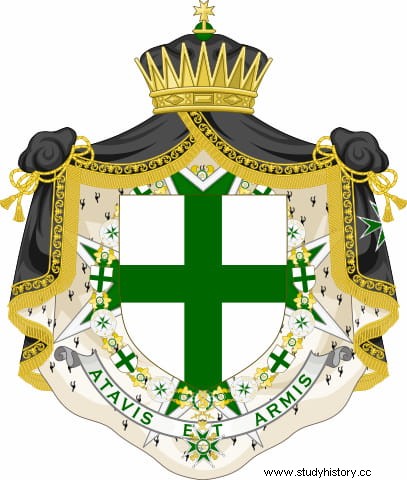It often seems that the chivalric orders were reduced to one, the much hackneyed and adulterated one of the Temple, but the truth is that there were many more and one of the pioneers was that of Saint Lazarus of Jerusalem.
Created centuries before the Crusades and initially dedicated to assisting the pilgrims who came to the Holy Places, it would later join the others in taking up arms to defend them. But the most significant thing about this institution is that, as its name indicates, it took special care of lepers , with the unusual peculiarity that it even admitted them into its ranks.
It is difficult to get an idea today of how terrible it was to suffer certain diseases for the people of other times. I'm not just talking about lethal illnesses like cholera or the Black Death (whose deaths were taken care of by the order of the Celites or Alexians), but also about illnesses that, even if they didn't kill the patient, turned him into an outlaw, thus not only he must have suffered from more or less severe symptoms in his body but also was left socially marginalized .
There is a very obvious example in history:leprosy, whose symptoms are so visually stigmatizing that, along with the obvious possibility of contagion, the sick were separated from the community and/or confined in so-called leprosy hospitals.

leprosy , although it is not currently considered particularly contagious thanks to treatments, it used to produce real terror due to the deforming nodules it caused on the skin of those who suffered from it, giving them a terrible appearance.
Of bacteriological origin (Mycobacterium leprae or Hansen's bacillus), although apparently related to a certain genetic predisposition, treatment was not found until the 20th century, so in other times the aforementioned isolation was resorted to and the obligation, on the part of the affected person, to carry some tablets that he had to make them collide with each other to warn of their proximity and let people get out of the way.
This instrument was known as tablets of San Lázaro , because said saint was designated patron saint of lepers and mendicants. And that name was also chosen to baptize one of the hospital orders that was dedicated to the care of these patients, presumably -according to their tradition- since in the year 370 Saint Basil the Great proclaimed himself master of a leper colony under the patronage of Saint Lazarus, although it would not be until the 11th century when it was organized as an order proper.
The First Crusade was the perfect context:Gerardo Tum , founder of the Hospitaller Order and rector of the hospital of Saint John of Jerusalem, put the facilities at the disposal of the conqueror of the city, Godofredo de Bouillon, who confirmed him as master. Later, an extramural lazaretto was detached from the hospital.
The first document that explicitly mentions the order is from 1227 (a granting of indulgences to those who donate alms to the hospital) and in 1255 a pontifical bull confirms that the Lazarists will be governed by the rule of Saint Augustine . By then, the new knights had already taken part in their first battle (Gaza, 1244), all the participants dying, and they continued in that line in Mansura (1250) and other campaigns, including the defense of San Juan de Acre against the Muslims. .

In the year 1255 the constitution Cum a nobis enacted by Pope Alexander IV endowed that hospitaller order with a military structure , then becoming governed by the San Basilio rule . Why that change? It was actually the result of circumstances.
As I said before, one of the unusual characteristics of the Knights of Saint Lazarus was that they could be lepers (although they did not participate in the election of the Grand Master). This disease, whose infection favored the deplorable hygienic conditions of war, affected many members of other military orders, something that made them incapable of continuing in them and they found in this other an alternative to continue with their lifestyle like warrior monks.
This seems to be deduced from the list of successors of Gerardo Tum (who died in 1120) and is corroborated in some fragments of the Book of Kings of the Latin Kingdom of Jerusalem , where it is specified that the Knights of Saint John and of the Temple who had contracted leprosy should abandon their habits to take the Lazarists . Consequently, a multitude of knights whose profession, basically, was that of arms, were incorporated, thus transforming or expanding the spirit of their new order.
The peak of the order took place during the reign of Baldwin III, a young thirteen-year-old monarch who had the regency of his mother Melisenda, since one of the crusaders, King Louis VII of France, took his country to a group of Lazarist knights, who thus made the leap to Europe .
Later, in 1174, he was crowned in Jerusalem Baldwin IV , known as the Leper King for obvious reasons, to whom the officialization of the new warrior character of the order is attributed.
Baldwin had himself escorted on his campaigns (battles of Beqaa, Montgisard...) by a body of Lazarists who fought stubbornly to the death because, after all, that was the fate that awaited them in case of defeat, since no enemy was willing to have prisoners with leprosy and executed them immediately.
Hence the famous feat of the knight Gismond D'Arcy , equally leper, who in full combat and seeing that the king had fallen and was surrounded, covered him with his body and cut off an arm that he threw at the attackers, putting them to flight terrified at the idea of catching it. In fleeing from him, the Islamics abandoned a flag with the characteristic green color Mohammedan, which from then on was associated with the Order of Saint Lazarus:a cross of that tone on a white background..
The Lazarists can also boast of having been the ones who protected the relics of the Holy Cross carried by the Bishop of Acre; they did it in a terrible battle, that of the Horns of Hattin (1187), which shortly after would allow Saladin to take Jerusalem.
The order, which lost its possessions in the holy city, would obtain compensation in Acre after its reconquest in the Third Crusade, building a new hospital and another leprosarium, and building several castles. An enrichment period was opened which ended abruptly in 1244, when the Crusaders received a new and resounding defeat that led to the extermination of all the Lazarists . This high mortality among the members of the order was due to the aforementioned reason and would be repeated more times throughout its history, as it happened again in the defense -and loss- of Acre in 1291.
The few survivors left in Palestine went to Europe , from whose borders the institution would no longer leave. Under the protection of the monarch Felipe el Hermoso (the Capetian, not the Burgundian) adopted the forms they still retain today, although they did not lay down their arms as they fought in Joan of Arc's army.
The greatest danger, however, came from Pope Innocent VIII's attempt to unify all the orders into one under the ascription to that of Malta; the French Crown evaded complying with the order of dissolution and that link between Lazarists and Gallic kings continued to be maintained .
Today the order continues to exist but has obviously abandoned the military to focus on caring for the sick; everyone, not just those with leprosy, because in any case this condition is being controlled and reduced little by little.
